Business processes are more complex and far-reaching today, especially with the massive increase in remote and hybrid work over the past few years. Business communication apps have become vital to keep in-house, remote, and hybrid teams that include both employees and external contractors all on the same page.
There are many types of business communication apps to consider, all designed to facilitate employee communication. In this post, we’ll discuss the different types of business communication apps and the top options in each category.
1. Unified Communications
Unified communications platforms — often called unified communications as a service or UCaaS — combine multiple communication channels into a single platform. You can make and receive voice calls, host video conferences, send instant messages, and share files from a single dashboard to streamline workflows.
These tools are often used for internal and external communication. Team members join video conferences when brainstorming new ideas, and customer support agents manage incoming client calls all within the same tool. This can simplify communication and streamline your workflows.
Let’s look at the best team communications platforms in 2024.
Nextiva

Best for: Reliable all-in-one UCaaS platform with exceptional customer support and industry-specific solutions.
Nextiva has multiple communication products, including the all-in-one team communication app and UCaaS platform NextivaONE. You can do the following in one single, user-friendly dashboard with our desktop app, browser site, or mobile app:
- Leverage Nextiva Voice’s VoIP phone system
- Make and receive voice and video calls
- Send emails
- Offer team SMS messaging for internal and external communication, including team and direct messages
- Access sales and service tools
- Review analytics
- Manage contacts, calendars, and more
- Host video conferences
- Manage call recording
- Share files
Nextiva offers exceptional reliability with access to 24/7 customer support and 99.99% uptime for our VoIP products. We also offer specialized features for select industries, including contact centers, health care organizations, nonprofits, and retail corporations.
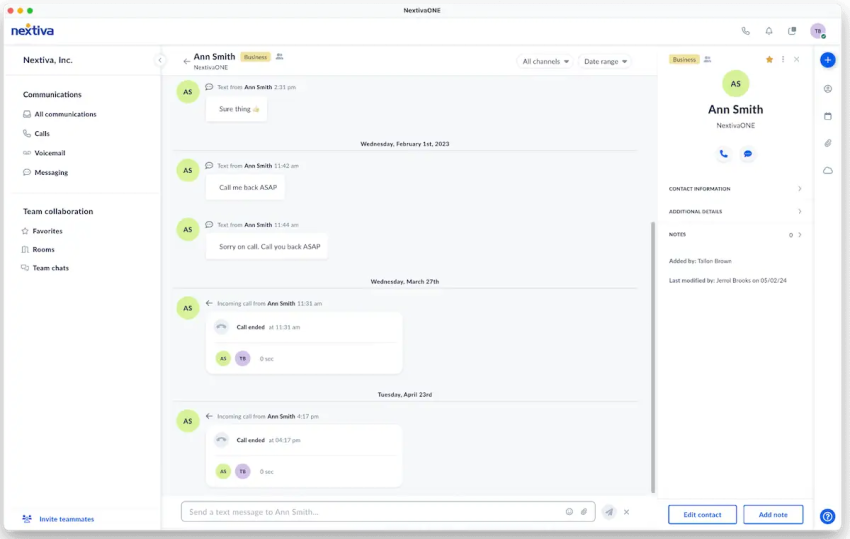
RingCentral

Source: RingCentral
Best for: AI-heavy communications features.
RingCentral is a UCaaS platform that focuses heavily on AI functionality. It offers over 20 different touchpoints with AI suggestions before, during, and after interactions to support agents and improve the customer experience. These features include AI call transcripts, intelligent virtual agents, and AI quality management.
Not sure if RingCentral is right for you? Check out these RingCentral alternatives to learn more.
Mitel

Source: Mitel
Best for: Larger companies already using Mitel’s suite of tools, potentially including on-premises solutions.
Mitel’s UCaaS suite includes voice, video, and chat solutions for businesses. It’s a reliable communication platform with a key focus on scalability options for large enterprises. Mitel’s platform is more complex overall, and the focus on scalability may mean that it’s not a solution for small or medium-sized businesses.
Wondering if Mitel is right for you? Check out 10 Mitel alternatives.
Zoom

Source: Zoom
Best for: Basic features for small businesses.
While Zoom’s best-known product is its video conferencing platform, Zoom Workplace is a solid UCaaS platform.
Zoom Workplace is workplace engagement and communication software with basic features such as team chat, phone calls, and meeting schedulers. The functionality of these features is simpler than other communication software options but may work for small businesses that don’t require advanced features with extensive customization options.
2. Team Messaging
Dedicated team chat apps focus exclusively on real-time chat functions for internal communication and collaboration. These tools often include channels for specific topics, the option for direct messages between individuals or small groups, file sharing, and integrations with other tools.
Slack
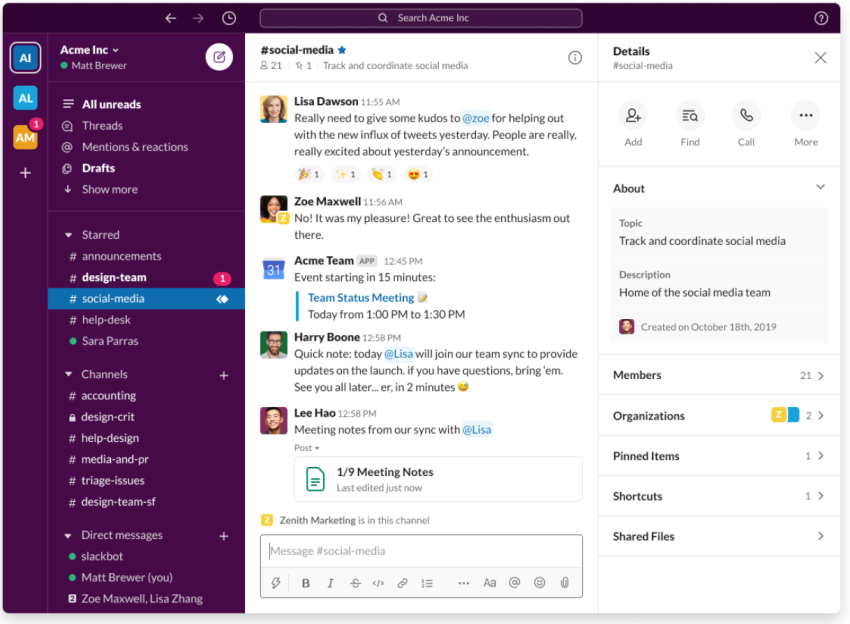
Source: Slack
Best for: Exceptional ease of use with features for customizable channels and guest access.
Slack is perhaps the most-known team messaging app and for fairly good reason.
It has an extraordinarily intuitive interface, so even your least tech-savvy team members can use it easily. You can set up team- or topic-based channels, create small group discussions, and share files easily with multiple integrations. Finally, there are simple ways to create guest accounts with restricted access or improved, real-time collaboration with external vendors and freelancers.
Flock

Source: Flock
Best for: Threaded discussions with knowledge base features.
Flock’s messaging platform has built-in collaboration features with knowledge base options, threaded discussions, and basic project management and file sharing functionalities. There’s also a built-in video and voice calling system with video conferencing options.
Microsoft Teams
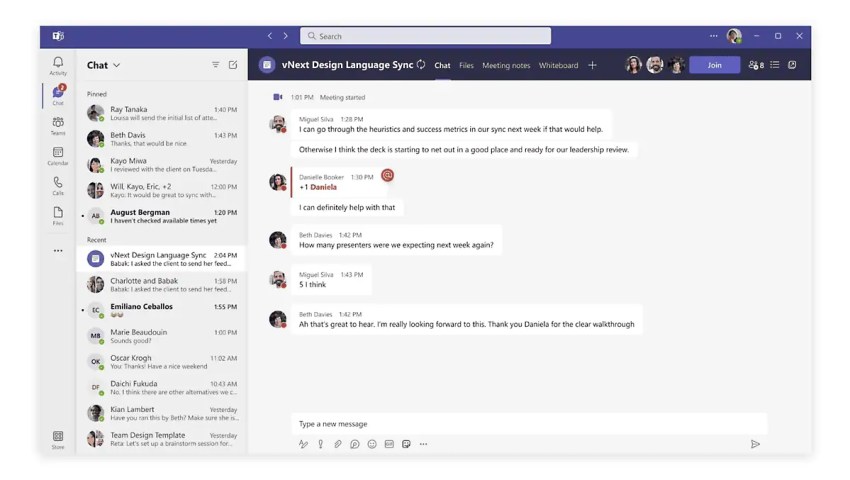
Source: Microsoft
Best for: Existing Microsoft customers and large teams.
Microsoft Teams is part of the Microsoft suite of tools. It integrates seamlessly with Office 365. While it does have a more complex interface than the other tools we’re looking at, it’s a good choice for enterprise-grade companies and large teams that are already using Microsoft. The platform has advanced features and makes data security a priority.
3. Video Conferencing
Video conferencing has become essential as more businesses create remote teams, with coworkers potentially collaborating across different time zones. These platforms enable face-to-face meetings with colleagues, clients, or partners across the globe.
Common features of video conferencing and virtual meeting platforms include screen sharing, call recording, in-conference chat, and real-time collaboration tools to facilitate teamwork.
Zoom
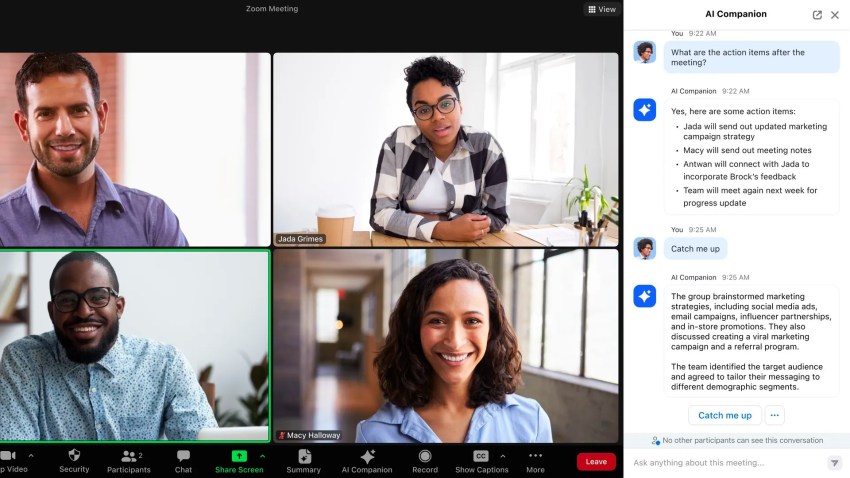
Source: Zoom
Best for: Free basic video conferencing for large meetings.
Zoom skyrocketed in popularity and became a household name during the COVID-19 pandemic. Many small and medium-sized businesses take advantage of Zoom’s free tier, which allows for up to 100 participants for up to 45 minutes without having to upgrade your plan.
Some of Zoom’s winning features include an intuitive interface, phone and desktop options, video call recording features, and straightforward screen sharing.
Microsoft Teams
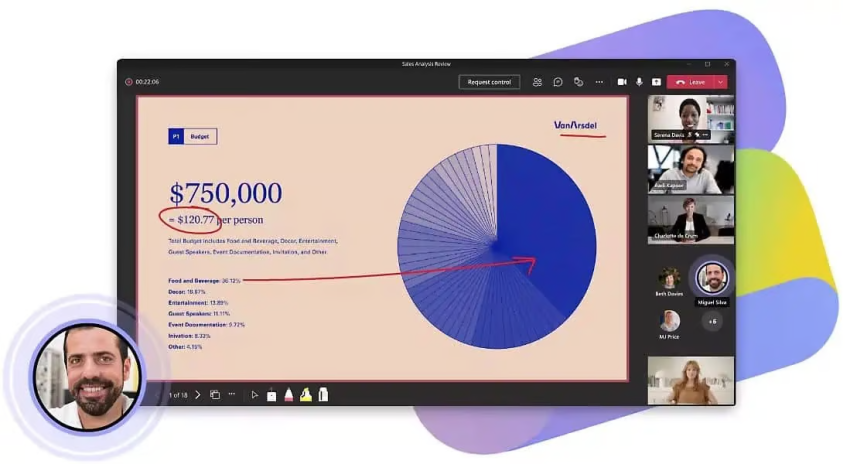
Source: Microsoft
Best for: Existing Microsoft users and large teams.
Microsoft Teams, once again, proves to be a reliable team communication option for video conferencing. It’s best suited for existing Microsoft users and large companies who need advanced functionality. Teams also has exceptional security standards in place, making it a popular choice for health care practitioners offering telecare appointments.
Google Meet

Source: Google
Best for: Remote-first focus with a simple interface.
Many people already have Gmail accounts, making Google Meet a convenient video conferencing option. It’s a remote-first option with a straightforward interface and basic scheduling functions. You can host up to 100 participants for up to 60 minutes at no cost.
Cisco Webex
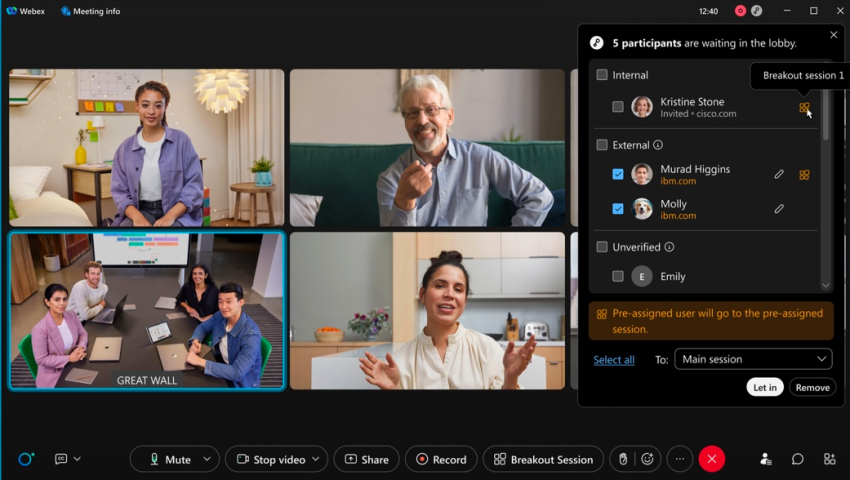
Source: Cisco
Best for: Video clarity and security.
Cisco Webex is best known for two distinct qualities: exceptional video clarity and heightened meeting security. It’s incredibly popular as a webinar hosting platform, but it’s also a favorite of large organizations that are concerned about data security and privacy.
4. Project Management
Project management tools facilitate team collaboration on projects with task management, file sharing, and progress tracking functionality. They often have features that include project-based discussion boards, deadline notifications, to-do lists, and customizable workflows. Some may also have productivity tools built in.
Trello

Source: Trello
Best for: Free plan with easy visual task management.
Trello is a Kanban-style project management tool. You can drag and drop cards from one board to the next to better track their progress. You can also add checklists, shared files, comments, and deadlines to each card for streamlined project management.
Trello has a great free plan that may be sufficient for small teams with simple project management needs. For this reason, it’s exceptionally freelancer-friendly and works well for different project types.
Asana

Source: Asana
Best for: Teams with complex projects requiring advanced features.
Asana is a popular project management tool. Like Trello, Asana uses Kanban-style board organization for easy progress visualization. Small and large teams use Asana, especially for more complex projects requiring advanced functionality.
Some of Asana’s standout features include project path visualization with multiple viewing options, extensive integrations, resource allocation, and project reporting dashboards.
Wrike

Source: Wrike
Best for: Analytics-driven resource management.
Wrike’s project management software has powerful reporting capabilities that can improve resource management and allocation. This platform has both Kanban-style boards and Gantt chart views, giving you diverse visualization options and strong collaboration features.
5. File Sharing and Collaboration
File sharing and collaboration tools allow team members to share documents, spreadsheets, and presentations easily. Some advanced tools may have features that include co-editing, version control, and secure access controls.
Google Drive
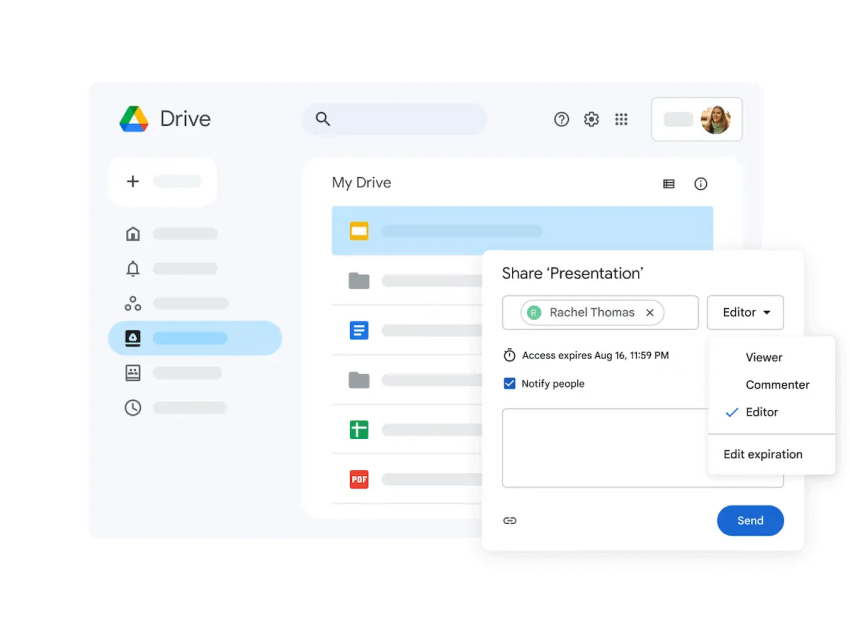
Source: Google
Best for: Ease of use for internal and external collaboration.
Google Drive is an exceptionally easy-to-use file sharing and collaboration platform. You can create word documents, spreadsheets, and slide deck presentations and collaborate with team members in real time.
This Cloud-storage giant integrates with other Google Workspace apps and allows team members to easily share access, add comments, suggest revisions, make edits, and track version history easily.
If you’re working with external team members or customers, Google Drive is highly convenient and a great option.
Microsoft OneDrive

Source: Microsoft
Best for: Teams using Microsoft’s 365 suite.
Microsoft OneDrive is part of the Office 365 suite, and if you’re already using the platform, this is likely the file sharing tool that makes sense to use.
This platform was designed with businesses in mind. Some standout features include expiring access, library syncing, sensitivity labels, enhanced visibility control, and implementation of configuration policies.
Dropbox

Source: Dropbox
Best for: Robust security features with document signing functionality.
While all the file sharing tools on our list are considered to be secure, Dropbox focuses heavily on robust security features. It offers user activity tracking, streamlined access management, and the option to securely send and sign documents electronically in-app with Dropbox Sign.
6. Email Marketing and Automation
Email marketing and automation platforms allow your team to create and send targeted email campaigns to customers and leads.
The best apps in this category include features such as email design functionality, optimized templates, list segmentation, and marketing automation workflows.
Mailchimp
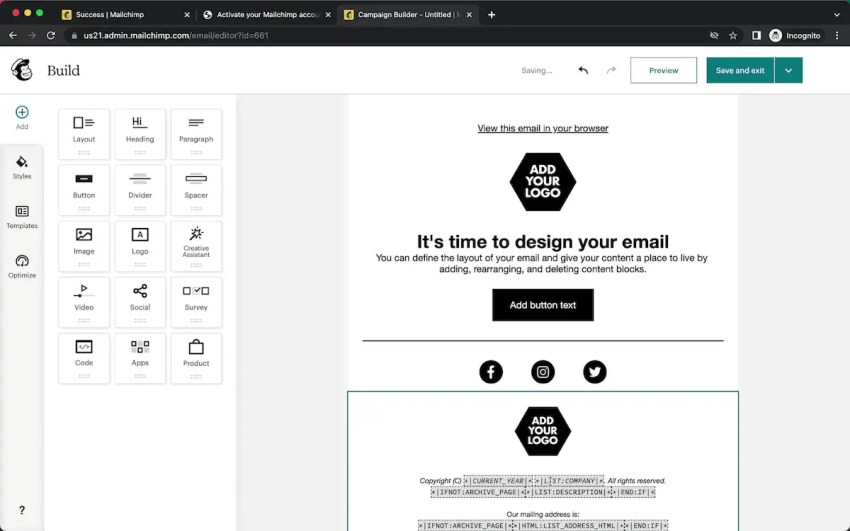
Source: Pageflows
Best for: Startups needing a professional email service
Mailchimp is the email marketing automation leader. It has the most user-friendly interface and an exceptional free version that’s fully functional for those with basic email needs.
Businesses who choose to upgrade to paid plans can take advantage of more advanced segmentation and autoresponder features, detailed email analytics, and AI-powered automations that consider audience intent and behavioral data.
Constant Contact
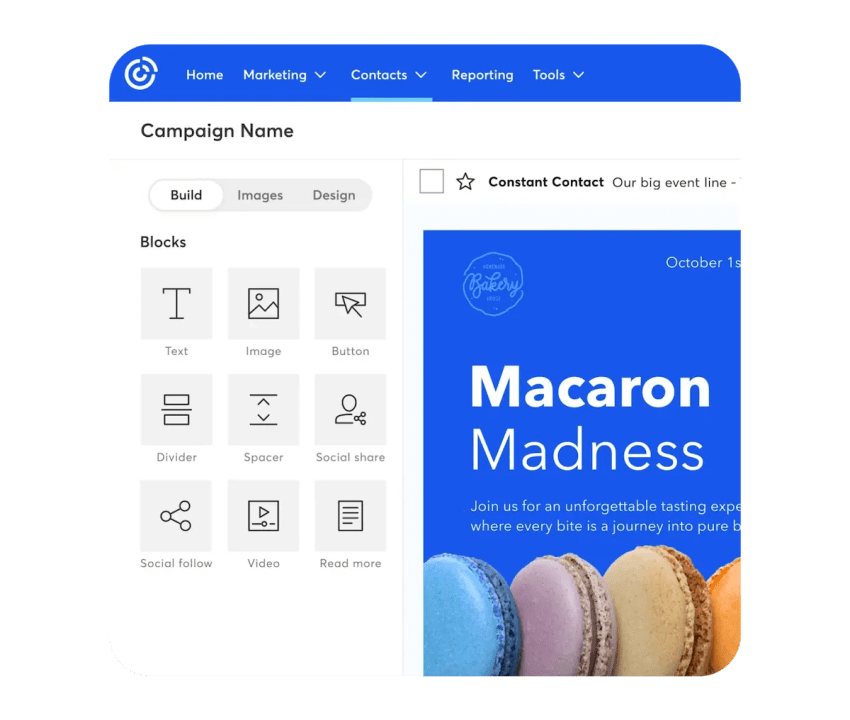
Source: Constant Contact
Best for: Mature organizations needing advanced analytics.
Constant Contact has advanced email reporting and analytics for multiple digital platforms, including email marketing. It also has hundreds of email template designs, generative AI features, and a simple drag-and-drop email builder.
Campaign Monitor

Source: Campaign Monitor
Best for: Drag-and-drop builder.
Creating visually appealing emails is an important part of email marketing, and Campaign Monitor can help with that. Its drag-and-drop builder and extensive email templates come with an easy-to-use interface. You can create gorgeous emails quickly, even if you don’t have a ton of experience.
SendGrid

Source: Twilio
Best for: Transactional emails and autoresponders.
SendGrid is phenomenal if you’re looking for a tool specifically to send triggered autoresponder campaigns. You can create autoresponder email campaigns at scale without sacrificing personalization or accuracy. This tool is more technical, created “for developers by developers” and centered around an email API.
What to Keep in Mind When Choosing a Business Communication App
When choosing a new business communication app — whether it’s your first one or adding to an existing tech stack — keep five key criteria in mind.
1. Team and working groups
Choose communication software with your team in mind.
Ask the following questions:
- How large are the teams using the software?
- What’s their communication style? Do they spend more time using instant messaging options or video calls?
- What are their key and immediate needs?
This can help you assess whether different tools can meet your team’s needs and at what cost.
2. Practical features
The features you need will directly impact the tools you choose.
A five-person marketing team may be just fine using the free Trello plan for project management, while a large organization’s 20-person marketing team may need the resource allocation features that come with Wrike or Asana.
The complexity of features needed will impact whether you need a specific tool or you can rely on an all-in-one solution.
Don’t forget to take a look at overlapping features when considering different products. You don’t want to pay for a dedicated instant messaging solution if you already have effective team chat features through your UCaaS platform, for example.
3. App integrations
It’s always a good idea to choose tools that integrate with your existing software. Popular integrations may include:
- CRM software
- Data storing platforms
- Project management tools
- Other communication solutions
4. Proven security
All communication apps should have security features in place to protect sensitive data, including internal and external communications, employee data, and customer information.
Look for software that has a clear focus on security, including security certifications and practices. This may include secure sign-on features, encryption, and data storing or sharing policies.
5. Ease of use
Ease of use is key when it comes to product selection. Advanced features are great — but only if your team can actually use them. Simple interfaces lead to smooth adoption and implementation, increasing the overall functionality of the tool itself.
As a note: If you have a small, highly technical team, ease of use may be traded for more advanced or complex features. When it comes to company-wide communication tools, however, it’s often best to opt for tool adoptability.

Unify Your Business Communications With Nextiva
There are so many different types of business communication apps, and many organizations have multiple communication platforms in their tech stacks.
Because there are so many options, it’s important to determine which features you need so you can choose the right ones for your business.
It’s also important to look at any tools you’re using and find potential redundancies. Some businesses may be using three or four tools when they only need one. This can make business communication processes more complex and confusing, as well as increase your overall tech spending.
Nextiva is an all-in-one unified customer experience platform. Our software has features that cover most of the functionality offered in each of the six categories discussed above.
Nextiva’s business communication solution has the following key features:
- Unified communications including phone calls, email, SMS, video, and more
- Streamlined file sharing
- High-quality voice and video conferencing
- Internal communication options, including group chats and direct messages
- Exceptional reliability and uptime
- Optional social media management tools
- Employee engagement features, including agent performance analytics
- Transparent pricing on all products
- AI-powered features to support agents and increase response times
Want to learn more? Get a personalized demo of our communication platform today. 👇
One app for all conversations.
Seamlessly manage all of voice, video, messaging with customers and team on a unified platform.

















 Productivity
Productivity 











